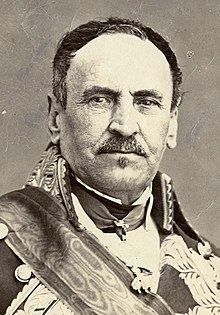
Back بالدوميرو إسبارتيرو Arabic بالدوميرو اسبارتيرو ARZ Baldomero Espartero AST Baldomero Espartero Azerbaijani Baldomero Espartero Catalan Baldomero Espartero German Baldomero Espartero Esperanto Baldomero Espartero Spanish Baldomero Espartero Basque Baldomero Espartero Finnish
You can help expand this article with text translated from the corresponding article in Spanish. (February 2009) Click [show] for important translation instructions.
|
Baldomero Espartero | |
|---|---|
 Espartero in 1865 | |
| Regent of Spain | |
| In office 17 October 1840 – 23 July 1843 | |
| Monarch | Isabella II |
| Preceded by | Maria Christina |
| Prime Minister of Spain | |
| In office 18 August 1837 – 18 October 1837 | |
| Monarch | Isabella II |
| Preceded by | José María Calatrava |
| Succeeded by | Eusebio Bardají |
| In office 11 September 1840 – 10 May 1841 | |
| Monarch | Isabella II |
| Preceded by | Vicente Sancho |
| Succeeded by | Joaquín María Ferrer |
| In office 18 July 1854 – 14 July 1856 | |
| Monarch | Isabella II |
| Preceded by | Ángel Saavedra |
| Succeeded by | Leopoldo O'Donnell |
| President of the Congress of Deputies | |
| In office 28 November 1854 – 4 December 1854 | |
| Monarch | Isabella II |
| Prime Minister | Himself |
| Preceded by | Evaristo Fernández de San Miguel |
| Succeeded by | Pascual Madoz |
| Minister of War of Spain | |
| In office 29 July 1837 – 30 August 1837 | |
| Monarch | Isabella II |
| Prime Minister | José María Calatrava |
| Preceded by | Ildefonso Díez de Rivera |
| Succeeded by | Evaristo Fernández de San Miguel |
| In office 16 December 1837 – 17 January 1838 | |
| Monarch | Isabella II |
| Prime Minister | Count of Ofalia |
| Preceded by | Jacobo María Espinosa |
| Succeeded by | José Carratalá |
| Personal details | |
| Born | Joaquín Baldomero Fernández-Espartero y Álvarez de Toro 27 February 1793 Granátula de Calatrava, Spain |
| Died | 8 January 1879 (aged 85) Logroño, Spain |
| Resting place | Co-Cathedral of Logroño |
| Political party | Progressive Party |
| Spouse | |
| Signature | |
Baldomero Fernández-Espartero y Álvarez de Toro (27 February 1793 – 8 January 1879) was a Spanish marshal and statesman. He served as the Regent of the Realm, three times as Prime Minister and briefly as President of the Congress of Deputies. Throughout his life, he was endowed with a long list of titles such as Prince of Vergara, Duke of la Victoria, Count of Luchana, Viscount of Banderas and was also styled as "the Peacemaker".
A "self-made man", Espartero was an exceptional case of social mobility.[1] With a humble origin, son of a cart-maker from a small village, he was originally destined to the priesthood yet he finally opted for a military career, taking part in the Peninsular War. He would become a champion for the Liberals after taking credit for the victory in the First Carlist War and replaced Maria Christina as regent of Spain in 1840.
Associated with the Progressive Party, he was one of the so-called espadones ("big swords"), general-politicians who dominated much of the political life of the country during the reign of Isabella II. He was ousted from the regency in 1843, temporarily distancing from politics. He was called to government after the 1854 revolution, opening the two-year period known as the Bienio Progresista.
Despite retiring from political life after his exit from government in 1856, Espartero maintained a cult following largely nurtured by the popular classes throughout the 1860s and, following the 1868 Glorious Revolution and subsequent overthrow of Isabella II, he emerged as popular candidate to become the head of state of the country, either as president of a republic or as king.[2]
- ^ Fernández Urbina 1979, p. 53.
- ^ Shubert 2015, pp. 211–213.